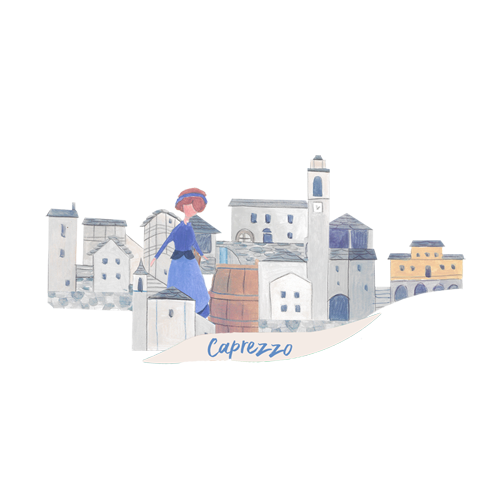Nel ‘700 da Caprezzo per lavorare andavano a Milano. Nella seconda metà del ‘700 il fratello del mio pentavolo, che si chiamava Guglielmo, è andato a Milano e ha messo su con la moglie un locale dove vendevano del vino. Raggiungevano Milano andando a piedi al lago, lo attraversavano con un barcone e arrivavano al Ticino dove prendevano il Naviglio Grande che passa da Abbiategrasso, Corsico e arriva a Milano. Quelli di Caprezzo erano tutti vignaioli: allora c’era l’uva nostrana qui, la lavoravano e la mandavano giù. Sotto, vicino al Circolo c’era un convento, e i frati lavoravano la campagna e le vigne. Comunque tutti i Caprezzesi erano vignaioli e bottai, mentre quelli di Intragna erano facchini, quelli di Miazzina e Cossogno lattai, ad Aurano lavoravano le campagne, gli orti, le vigne, a Vignone e Bureglio facevano le botti. Ancora nell’800 le vigne producevano uva che dava ottimo vino: la “nostrana” che, in piccola quantità vicino alle case, esiste ancora; la “curberǣ” prodotta da viti tipiche del luogo e antiche; l’uva bianca “töppiǣ” di cui mi dicevano esserci un pergolato in località Madonna del Sasso. Dalla seconda metà dell’800 la qualità dell’uva peggiorò e il vino buono veniva comprato fuori paese. A Caprezzo si coltivava allora l’uva “mericana” che dava un vino piuttosto aspro e di bassa gradazione. – Graziella Caretti, 2018 –
In the 18th century they went from Caprezzo to Milan to work. In the second half of the 18th century, the brother of one of my ancestors, Guglielmo, went to Milan and started an activity to sell wine with his wife. They reached Milan by walking to the lake, crossed it with a big boat and arrived at the river Ticino where they took the Naviglio Grande that crosses Abbiategrasso, Corsico and arrives in Milan. The inhabitants of Caprezzo were all winegrowers: there was the local grape, they processed it and sent it down. Below, near the Social Club, there was a convent, and the friars worked in the countryside and in the vineyards. All the inhabitants of Caprezzo were winegrowers and coopers, while those of Intragna were porters, those of Miazzina and Cossogno were milkmen, in Aurano they worked in the countryside, in vegetable gardens and vineyards, in Vignone and Bureglio they made barrels. In the 19th century the vineyards produced grapes that gave an excellent wine: the “nostrana” that, in small quantities near the houses, still exists; the “curberǣ”, produced by local and ancient vines; the white grape “töppiǣ” of which there was a pergola in Madonna del Sasso. In the second half of the 19th century the quality of the grapes got worse and the good wine was bought out of the village. In Caprezzo, the “Mericana” grape was cultivated, which gave a rather sour and light wine. -Graziella Caretti, 2018 –
TI TROVI A
YOU ARE IN
